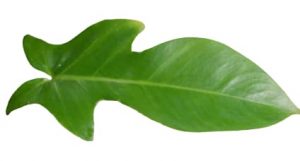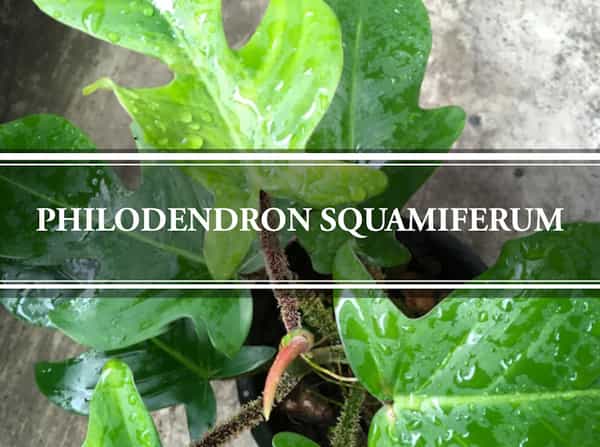Are you a fan of unique climbing houseplants? We are introducing another striking Aroid, the Philodendron squamiferum plant. This American native plant has green, oak-shaped, and multi-lobed leaves.
Moreover, the long reddish petioles with fine and fuzzy hair-like growth enhance the appearance of this plant. A mature one can get about a few feet in height.
This plant is a nice choice for indoor ornamental plantations. Besides, you can grow them outdoors in a moderate climate and with specific care. Mark my words! This Philo will surely be a cherry on the top for your interior and plant collection.
And all this without needing any green-thumb! Sounds interesting, right? Keep reading to learn more about the Squamiferum Philodendron Plant.
Philodendron Squamiferum Classification
Family: Araceae.
Genus: Philodendron.
Species: P.squamiferum.
Genus Philodendron:
Around 500 plant species combine to form one of the most popular genera in common man plantation. The majority of the species have been hybridized on large scale to include a large number of plants in the collection. Back in the 16th century, C.Plumier was the official introducer of this genus. Moreover, they have been popular in ancient culture for ages.
These natives of American rainforests include both climbing and non-climbing plant species. They own a popular position in both indoor and outdoor ornamental plantations.
Features of the Philodendron Squamiferum Plant

Size and structure:
- The climber can get about 4 to 5 feet in the indoor atmosphere. You just need to add a supporting totem in the plant to help it achieve a good look.
- The baby plants look pretty good to add some class to your table. Howbeit, once the plant grows and gets adult, it needs a trellis to climb upon. Hence shifting it to the ground is the only choice.
- The climbing nature and multi-lobed leaves make the plant resemble the cousin Monstera deliciosa and sibling Philodendron bipennifolium plant.
Leaves:
The shiny and dark-green multi-lobed leaves can get about 5 to 15 inches long on maturity.
Flower:
- You may see the plant blooming with typical Aroid flowers growing on warm days. A large modified leaf, the spathe covers the spadix. This looks like a large flower. However, numerous and tiny whitish flowers grow on the spadix, which are the real flowers of the plant.
Toxicity of Philodendron Squamiferum:
Beware of the toxicity. This beautiful climber too owns the toxic legacy. Higher levels of calcium oxalate crystals make it harmful for both humans and pets. Close contact leads to skin allergy and rashes. Moreover, ingestion causes blisters in the mouth and oesophagus. Make sure you keep kids and pets away from mingling with the plant.
Philodendron Squamiferum Care
Just like other members of the genus, this one too is an easy-to-grow-plant. Just follow the specific rules and the plant stays happy with everyone including the beginners.
Quick Guide:
Water: Average (Water right after the upper layer gets slightly dry)
Sunlight: Bright to the medium indirect sun.
Humidity: Prefers higher and tolerates lower levels.
Fertilizer: Monthly doses in mild concentration in the growing season.
Still with us? Let us learn further to understand the requirements in detail;
Water Requirements
Follow the basic Philodendron watering strategy. Water the soil thoroughly and wait for the upper layer to get dry before watering again.
The water requirement and frequency is variable. Also, it depends upon factors like temperature, sunlight, humidity, and ventilation. Understanding the drying pattern of soil helps you maintain the watering schedule. Talking about an estimated frequency, once to thrice a week is enough for the warm days. While the water requirement of the plant decrease with slow growth in the cold. So, once every ten to twenty days is usually enough after the fall.
Wet and soggy soil can cause root rot. Thus, make sure you never water the soil unless the upper 2 inches lose the previous moisture.
Sunlight Requirements
These natives of tropical forests tend to climb tall trees getting dappled sun. So, medium to the bright indirect sun is what they love. The importance of proper sunlight is unavoidable. Inadequate sun can lead to poor and leggy growth. Besides, there are high chances of soil staying wet for long, causing root rot. On the other hand, strong direct sun can scorch out the foliage.
Soil Requirements
Choose a well-draining and organically rich growing medium. It is better to choose more than simple soil for indoor potted plants. This will help you avoid many disease-causing microorganisms.
Simple houseplant potting mix serves well enough. Moreover, you can add perlite or orchid bard to enhance drainage.
Temperature Requirements
A temperature range of 65 to 85 °F is ideal for the foliage of your Squamiferum plant. In short, a room temperature that is comfortable for you will be enough to keep the plant healthy. Just like other Philodendrons, this plant too has poor tolerance for cold and frost. Hence, it is important to bring them indoors to some warm spot it gets colder than 50 °F.
Humidity Requirements
Philodendron squamiferum is a native of tropical rainforests. So, you can easily understand its love for humidity. Higher moisture levels in the air give a plump and lush look to the plant. However, this resilient peep will not protest enough against the lower humidity levels.
On dry days of winter, it is better to provide adequate moisture. For this, you can follow several methods. Placing the plants together enhances the overall moisture level for all of them. Secondly, you can use a room humidifier or a pebble-water tray under the pot.
If you want to know, the Pebble-water tray technique is quite simple. You just need a large deep tray and place a few pebbles in it. Fill the tray with water, keeping the level below the pebbles. Now, place the pot on these pebbles. Make sure the water doesn’t touch the drainage holes and the soil of the pot.
Misting is another method to combat dryness. Howbeit, the foliage should not wet for long. So, the plant should stand in a well-ventilated place.
Fertilizer Requirement
These peeps love to get some additional nutrition in their growing season. Use a quality houseplant fertilizer in mild concentration. It is better to use lesser than half of the stated dose. This will help you to avoid over-fertilizing which can burn and even kill the plant.
Now, coming towards the type of fertilizers. Slow-release fertilizers are ideal for potted and container plants. On the other hand, liquid and slow-release granular fertilizers are more suitable for indoor than outdoor plantation. While the best option for outdoor plantation is a quick-absorbing granular fertilizer.
Pruning Requirements
Want your plant baby to get healthy and look cool? Removing the unhealthy foliage will be a help your plant to get healthy and look cool. Older and damaged leaves are a burden on the plant body. Besides, they give an unpleasant look to your plant and the surroundings. Simply cut them with the help of a sterilized knife.
Growth Zones
USDA Zones 4a to 11 is ideal for keeping the plant indoors. While in zones 9b to 11, this Philodendron can stay happy outdoors throughout the year.
Philodendron Squamiferum Propagation
Thinking about making some now Philodendrons? Good news! It is not that tricky! Keep reading to get the details.
Common methods of propagation include:
- Air-layering.
- Seeds
- Stem cuttings.
You may get a pack of seeds and propagate them according to the instructions. However, the seeds will make you wait longer before you get a well-grown plant. On the other hand, the air-layering method is a better choice for expert growers and cultivators.
Propagation by Stem-cutting:
Season:
Try getting some new plant babies in the middle of the spring up till the middle of the summer.
Method:
- Cut a few stems with at least a leaf at the top. Make sure you get the aerial roots or nodes on your cutting.
- If you have some growth hormone around, dip the lower ends of cutting in it. Shake the cuttings to shed off any excess.
- Plant the cuttings in the moist well-draining potting mixture. Keep the aerial roots under the soil to form the rooting system.
- Water the mixture mildly right after it gets about 50% dry. This will help to provide the necessary moisture during the shoot development.
- Roots start developing after the initial month. This leads to the development of tiny shoots usually after the sixth week.
- Keep taking care of the baby plant for about four months. You will see a well-grown decorative plant after about 4 to 5 months. At this stage, you can simply follow the care, as shared in the previous section.
Precautions:
Don’t forget to wear gloves while handling the plant and cuttings.
Related Post:
Summary
Philodendron squamiferum is a beautiful uncommon climber, admired for its unique foliage. The dark-green, oak-shaped, and multi-lobed leaves grow on reddish petioles. Moreover, these petioles are covered with fine hairy structures, botanically known as pubescence. They are suitable enough for indoor and outdoor plantation in a moderate climate. You can get the younger plants for tabletops.
On the other hand, adult ones need to stand on the floor with their supporting totems. Coming towards the care, these resilient peeps are quite easy to grow. Indirect sun and frequent watering are the basics to keep the plant happy. On final notes, it is important to mention the toxicity. Don’t let kids and pets play with your Squamiferum plant to avoid toxic reactions.

